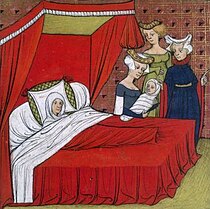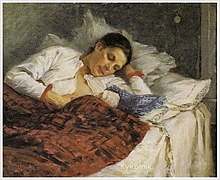
Childbirth, also known as labour, parturition and delivery, is the completion of pregnancy where one or more babies exits the internal environment of the mother via vaginal delivery or caesarean section. In 2019, there were about 140.11 million human births globally. In the developed countries, most deliveries occur in hospitals, while in the developing countries most are home births.

Postpartum depression (PPD), also called postnatal depression, is a type of mood disorder experienced after childbirth, which can affect both sexes. Symptoms may include extreme sadness, low energy, anxiety, crying episodes, irritability, and changes in sleeping or eating patterns. PPD can also negatively affect the newborn child.

The postpartum period begins after childbirth and is typically considered to last for six weeks. However, there are three distinct but continuous phases of the postnatal period; the acute phase, lasting for six to twelve hours after birth; the subacute phase, lasting six weeks; and the delayed phase, lasting up to six months. During the delayed phase, some changes to the genitourinary system take much longer to resolve and may result in conditions such as urinary incontinence. The World Health Organization (WHO) describes the postnatal period as the most critical and yet the most neglected phase in the lives of mothers and babies; most maternal and newborn deaths occur during this period.

In Christian tradition the churching of women, also known as thanksgiving for the birth or adoption of a child, is the ceremony wherein a blessing is given to mothers after recovery from childbirth. The ceremony includes thanksgiving for the woman's survival of childbirth, and is performed even when the child is stillborn, or has died unbaptized.

Lying-in is the term given to the European forms of postpartum confinement, the traditional practice involving long bed rest before and after giving birth. The term and the practice it describes are old-fashioned or archaic, but lying-in used to be considered an essential component of the postpartum period, even if there were no medical complications during childbirth.
A postpartum disorder or puerperal disorder is a disease or condition which presents primarily during the days and weeks after childbirth called the postpartum period. The postpartum period can be divided into three distinct stages: the initial or acute phase, 6–12 hours after childbirth; subacute postpartum period, which lasts two to six weeks, and the delayed postpartum period, which can last up to six months. In the subacute postpartum period, 87% to 94% of women report at least one health problem. Long term health problems are reported by 31% of women.

A monthly nurse is a woman who looks after a mother and her baby during the postpartum or postnatal period. The phrase is now largely obsolete, but the role is still performed under other names and conditions worldwide.
Pumsavana Simantonayana is a combined performance of the two Hindu rites of Pumsavana and Simantonnayana, practised during the contemporary period.
This article deals with childbirth in Japan, and the specific details of childbirth exclusive to Japan in relation to beliefs, attitudes and healthcare.
Childbirth in Haiti follows a system of behavior determined by local beliefs, traditions and attitudes, and is also affected by economic conditions and limitations of available health care facilities.

Impurity after childbirth is the concept in many cultures and religions that a new mother is in a state of uncleanliness for a period of time after childbirth, requiring ritual purification. Practices vary, but typically there are limits around what she can touch, who she can interact with, where she can go, and what tasks she can do. Some practices related to impurity after childbirth, such as seclusion, overlap with the more general practice of postpartum confinement.
This article provides a background on Nepal as a whole, with a focus on the nation's childbearing and birthing practices. While modern Western medicine has disseminated across the country to varying degrees, different regions in Nepal continue to practice obstetric and newborn care according to traditional beliefs, attitudes, and customs.
Childbirth practices in India are shaped by the prevalence of religious customs and joint-family living, India's young average population, the lower national average age at marriage, and disparities in social status and literacy between men and women. Inadequate maternal health care services in India are a result of poor organization, the huge rural-urban divide, and large interstate disparities coupled with stringent social-economic and cultural constraints.
In its early history, Mexico was occupied by a large number of indigenous tribes such as the Mayans and Aztecs. In the 16th century, Spain colonized New Spain and took over the land from the indigenous peoples. Though it is now an independent nation, Mexico retains much of the cultural influence of Spain, including its official religion of Catholicism, the Spanish language, and the importance of machismo - the belief that men are superior to women. Mexico also retains much of the traditional beliefs of the indigenous peoples who first occupied the country. Besides Spanish, there are over one hundred different languages spoken in the country today. As a result, the current medical system involves a mix of traditional and Western medicinal techniques.
Postpartum care or postnatal care is a service provided to individuals in the postpartum period, to help with postpartum recuperation and restoration.
Sanhujori is the Korean culturally specific form of postpartum care. It includes consuming healthy foods, doing exercise and warming up the body. The sanhujori period typically lasts approximately from one week to one month. Sanhujori is a compound word: 'sanhu' and 'jori'.

A menstruation hut is a place of seclusion or isolation used by certain cultures with strong menstrual taboos. The same or a similar structure may be used for childbirth and postpartum confinement, based on beliefs around ritual impurity. These huts are usually built near the family home, have small doors, and are often dilapidated, with poor sanitation and ventilation, and no windows. The Nepali version, the Chhaupadi, is probably the best-known example, but cultural attitudes towards menstruation around the world mean that these huts exist, or existed until recently, in other places as well. The use of menstrual huts continues to be a cause of death, from exposure, dehydration, snake bite, smoke inhalation, and so on. The use of these huts is illegal in some places.
This article documents traditional and some modern childbirth practices in Korea. Korea has some special cultures in terms of childbirth. An interesting fact about Korea’s childbirth is that Korea reached 0.95% birthrate in 2019, which is the lowest among OECD countries. Most of the women go to the hospital for childbirth these days. There is a special place for the postnatal care center, which is called Sanhujori center.
Childbirth in China is influenced by traditional Chinese medicine, state control of reproductive health and birthing, and the adoption of modern biomedical practices. There are an estimated 16 million births annually in mainland China. As of 2022, Chinese state media reported the country's total fertility rate to be 1.09. In 2023, there were 7.88 million births.

Ọmụgwọ is an Igbo word of the South-Eastern Nigeria that describes the process of which a family member takes care of a new mother and her baby, in a short period of time after childbirth. Ọmụgwọ can be done during the first 40 days of a child's life or more. In most cases, it is the child's grandmother or grand step-mother that would stay during the period of ọmụgwọ. In their absence, the mother-in-law will replace the grandmother or grand step-mother. The importance of this practice is that it helps the new mother learn and be guided on the process of childcare through the experience of her mother or mother-in-law, it guides them on becoming a mother, by providing knowledge and support.













